Krishnendu Ray depicted some of the markets in Delhi selling street food that are deeply related to the liveliness of the city and the livelihood of the poor. Actually I have been to a very one when I was on a trip in Delhi, as a member of the Tsinghua India Immersion Program during my senior year (Here is a Vlog edited by me.)
In the market, you can try specialties like Jalebi, buy souvenirs like block-printed scarves, hear disco or hiphop music playing and watch people dancing. It’s neither too high-end or low-class. There was a joyful atmosphere, or in Ray’s notion, an atmosphere originated from the “rich, milling, sensuous public life”, for everyone to engage in. The buddies at Jindal Global University told us that they would go downtown for the market almost every weekend to buy food from different regions (especially those from their hometown) and get some entertainment with their friends. I was very impressed then as I hadn’t experienced such a fascinating weekly event in China with local cultural odor of urban life.
pc to Sophie Zhang
Now city planners and administrators in China have realized the importance of street vending in activating local economic vitality and leading the trend. Shanghai Night Festival was initiated at June 6, including Waitanyuan Night Carnival (for a few days) and BFC Fengjing Weekend Market (on Saturday and Sunday each week until Jan. 3, 2021). Both street markets are located in the busiest district of Shanghai, with gorgeous skyline of the bund and artistic architecture of Fosun Foundation.

“Street food has the potential to change the flavor of the politics and poetics of good taste.” It is evident that the planners would like to position the weekend market as a stylish and high-end attraction targeting at the younger generation to cater to their specific consumption needs, such as experiencing, socializing, and showing their personalities and aesthetics.
BFC Fengjing Market are 300 meters in length, including more than 110 brands, stalls, and pop-up shops. The vendors are serving leisure food like kebab, sushi, snacks, bubble tea, and beer. Foreign food and beverage are especially popular, DIY cocktail, for example. There are also various trendy youth cultural elements embodied in the live shows and interactive activities. Here street vending is no more associated with impressions like “littery, chaotic”; instead, it has become a creative and entertaining junction.
Street foods do make beautiful pictures. If you search for “Waitan Fengjing” on the social platform Red (to share sophisticated pictures and lifestyles), nearly 600 results will be shown. Images and information of such an event can travel well on SNS, proving that it is a successful business model with a gene of fashion.
The planners have enacted thorough and detailed logistic support process including dealing with trash. There are five locations for waste collection at the market with different allocation of classified dustbins according to different types of the stalls nearby. They have also set a dishwashing place to make sure the site is neat and ordered.
In a word, street vending in this era has been presenting a brand-new face. It is about the updated lifestyle of urban residents. But I’m not sure whether such a high-end version of street vending have much to do with the livelihood of the poor.








Leave a Reply